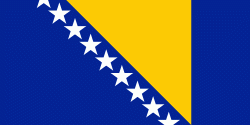Kupres (Opština Kupres)
Kupres (Купрес), also known as Kupres Republike Srpske (Купрес Републике Српске) is a municipality in western Republika Srpska, an entity of Bosnia and Herzegovina. It is bordering the region of Bosanska Krajina to the north. It is one of the most undeveloped and poorest municipalities in Bosnia and Herzegovina. The seat of the municipality is the village of Novo Selo.
The municipality was formed after the formation of the two entities of Federation of Bosnia and Herzegovina and Republika Srpska which together comprise the sovereign state of Bosnia and Herzegovina. The creation of the two entities split the original municipality of Kupres in two, one municipality in Federation of Bosnia and Herzegovina and the other in Republika Srpska. During the war the municipality name was changed to Srpski Kupres (Српски Купрес), but since then the Government of Bosnia and Herzegovina has forbidden the use of that name in order to avoid nationalistic sentiment.
As of 2019, it is one of the smallest municipalities by number of inhabitants in Republika Srpska.
The municipality was formed after the formation of the two entities of Federation of Bosnia and Herzegovina and Republika Srpska which together comprise the sovereign state of Bosnia and Herzegovina. The creation of the two entities split the original municipality of Kupres in two, one municipality in Federation of Bosnia and Herzegovina and the other in Republika Srpska. During the war the municipality name was changed to Srpski Kupres (Српски Купрес), but since then the Government of Bosnia and Herzegovina has forbidden the use of that name in order to avoid nationalistic sentiment.
As of 2019, it is one of the smallest municipalities by number of inhabitants in Republika Srpska.
Map - Kupres (Opština Kupres)
Map
Country - Bosnia_and_Herzegovina
 |
 |
| Flag of Bosnia and Herzegovina | |
The area that is now Bosnia and Herzegovina has been inhabited by humans since at least the Upper Paleolithic, but evidence suggests that during the Neolithic age, permanent human settlements were established, including those that belonged to the Butmir, Kakanj, and Vučedol cultures. After the arrival of the first Indo-Europeans, the area was populated by several Illyrian and Celtic civilizations. Culturally, politically, and socially, the country has a rich and complex history. The ancestors of the South Slavic peoples that populate the area today arrived during the 6th through the 9th century. In the 12th century, the Banate of Bosnia was established; by the 14th century, this had evolved into the Kingdom of Bosnia. In the mid-15th century, it was annexed into the Ottoman Empire, under whose rule it remained until the late 19th century. The Ottomans brought Islam to the region, and altered much of the country's cultural and social outlook.
Currency / Language
| ISO | Currency | Symbol | Significant figures |
|---|---|---|---|
| BAM | Bosnia and Herzegovina convertible mark | KM or КМ | 2 |
| ISO | Language |
|---|---|
| BS | Bosnian language |
| HR | Croatian language |
| SR | Serbian language |















